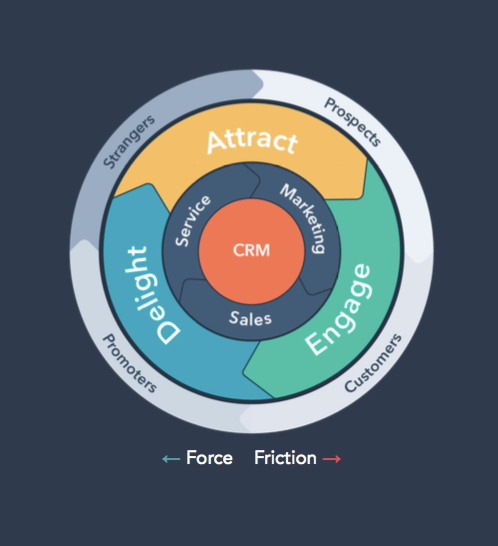Eric Peters is a Product owner on a small but mighty piece of the HubSpot platform called HubSpot Academy.
This article is adapted from his talk given at Product-Led Summit, London 2019.
"Why do we talk about our users as if we're running a military sting operation on them? I want to help you inject some humanity back into your product-led growth strategy.
This is my first time in London. It’s an amazing city. Before I came, my colleagues had these interesting things to say about London. ‘It has 8 million people.’ ‘It's almost as big as New York City.’ ‘You have to go get tea here.’ ‘You’ve got to go get Indian food there.' ‘You can't say awesome too many times.’
That built up a particular perception of London in my mind. I hadn't experienced it for myself. So that was my reality.
That rings true for your products as well. The perception that your prospects have for your product is their reality. So, how can you influence that perception?
The flywheel model
"HubSpot has bet its business on a flywheel model. We take into account the power of our customers. You embrace the fact that they're your biggest, loudest marketing team, your most helpful support reps, and the fact that they're your most efficient and consultative sales team."

"We aim to attract people, engage them and delight them. If you can delight them and if you can exceed their expectation, you can make them promoters. It's in our human nature that when we find something that has exceeded our expectation, we brag about it. It makes you feel smart to go and tell other people that you found this cool product. That's powerful."
HubSpot and HubSpot Academy
"Let me give you a bit of background.
HubSpot is marketing, sales and customer service software that targets small and medium sized businesses. 20 to 200 people are in our target. More recently, it's more like 2000 people. But at the time of founding of HubSpot Academy, it was smaller.
We provide specific marketing software. But, we found that with marketing software, you can't just teach the customer how to use it.
If you take a bad marketer and give them marketing automation software, it's a productivity tool. It’s just going to make them worse faster. We needed to first teach our customer how to be better at marketing, so that they could better use our software.
That is how HubSpot Academy started.
It began back in 2012 as a customer enablement and partner enablement channel.
In 2013, we released the first inbound certification. This was a very modern digital marketing course with an exam at the end of it. It wasn't the best SEO course and it wasn't the best content marketing course, but it was the best at bringing them all together into one holistic strategy that we call the inbound methodology.
This inbound methodology lines up perfectly with our software. If you learn it, the best way to apply it was with HubSpot. That was the strategy.
Soon though, we noticed something interesting. We saw people sneaking into it that weren’t our customers or our partners. We didn't expect anyone other than those groups to feel any motivation to take it.
When our salespeople started talking to those non-customers and non-partners who had now become potential prospects, they were having productive conversations. These prospects had just taken a four hour course on the inbound methodology.
Our salespeople realised, 'I usually spend the first 20 minutes of my call teaching these people what inbound methodology is, and now they're coming to the door knocking, wanting to buy the software so they can apply what they have just learned.'
So, we decided to open it up to everyone and Academy became an acquisition channel.
The online course market is growing really fast. Its a $25 billion market. There’s a high demand for self service and education. We built up HubSpot Academy into the HubSpot product as a learning management system. So, if you've ever taken an online course you generally have a feel for what HubSpot Academy looks like.
We've gone from about 1000 signups to 30,000 signups per month. People wanted to learn about content.
Let's run through some lessons we that we also learned whilst doing this."
Lesson 1. Empathy
"We focused on understanding that there are people behind those line graphs and bar charts that we look at every day. These are humans with rich complex lives, every bit as rich and complex as ours.
You might think this is all a bit fluffy?
Now, when I say empathy, I don't necessarily mean the pain points that your software solves.
I’m talking about knowing your persona and knowing them like a friend.
You need to be able to know what jokes they would laugh at around the dinner table, what kind of car they might drive or how they get to work.
Your product is a tiny percentage of their life. And so if you can figure out the rest of their life, you have a much better time of contextualizing your product.
When I started at HubSpot, I was a data monkey.
‘I can find out everything I need to know about these users from pivot tables and behavioral analytics.’
What I would get is this top-down view. You can see the traffic congestion in the streets, you can see where there's friction. But, you can't see that this person just joined the company, is learning 20 pieces of software along with this one and can't even remember which username they need to sign in with.
You don't know that this person needs a vacation and they're just signing up for your product and then leaving for two weeks. They look like a disengaged user, but really, they're just on their honeymoon."
Customer communication
"Go talk to your prospects because you'll get so much richer information out of them than you will just by looking at data.
You have to combine the quantitative research and qualitative research to really get the full picture.
I do multiple user interviews per week.
I had someone from France. I asked them, 'How would you find a social media course at HubSpot Academy?' I had them share their screen with me and show me what they would do. Like any typical online course provider, Hubspot Academy has filters, a search bar, lots of ways a user could find what they want. But, this particular user just hits ‘CTRL F’, types the word ‘social’, so that the social media course is highlighted.
We would have never known that was the way a user would find social media in the course. Unless we talked to them and watched them do it."
Lesson 2. Positioning
"We had an idea of who we were talking to, so now we had to position our product to our target audience.
When we did those user interviews, we saw this clear dichotomy between the two groups. There were the people who were focused on the certification you would get after taking the course. They wanted to prove that they had attained some level of knowledge. We had hiring managers that were customers who would onboard new employees and would say ‘take the certification and show me once you got it.’
And then there were other people like freelancers and students. They all were very focused on the credentials. They weren’t the users I was focused on.
As an acquisition channel, I needed Marketing Managers, VPS of marketing. People who might buy software sometime in the next 90 to 100 days.
These groups didn't care about the credential at all. They cared about the course. They wanted to stay up to date on the latest digital marketing tactics. While we had marketed HubSpot Academy as a certification program, we needed to be marketing it as an online course provider.
That positioning switch centered Hubspot Academy on a different part of the flywheel and dramatically changed the amount of people we had buying our product. I needed those users to be able to tell their friends HubSpot has an online course provider. I didn't want them to say HubSpot has this certification program. Because HubSpot having an online course provider sounds more applicable to people.
We watched for the full flywheel effect. We attracted a lot of students, a lot of freelancers. People who we were happy to have in the ecosystem."
Lesson 3. Growth Levers
"We know who we're talking about, who we're talking to, and we know how to talk to them. It's time to put some gasoline on the fire.
It was our users who told us how to do this. ‘We want this course in Spanish and Portuguese.’ ‘We want more advanced courses. An entire course on SEO.’
So we did both of those things."
Project 1: the languages
"We told ourselves that we were localizing the inbound certification to Latin America, but what we were doing was translating it. We ran it through a vendor. We added we added the transcriptions and SRT files to the videos and they were subtitled. We had our internal marketers for that region check it.
This didn’t go too well.
These users were emotionally engaged. They're doing this for their career. They want to put food on their table. They need that promotion. They want to get my kids to camp this year.
And so, when the test question doesn't match up in wording with the course video, they're annoyed. ‘I should have the certification, but because you didn't translate it perfectly, I don't.’ All hell breaks loose.
We can't just roll it back. We’ve just released a new language to thousands of people. We had 80,000 people in Latin Americaon our database at that point,. They’re all excited about taking this course. And they're all failing it. Pass rates are significantly lower than in English. We had to just keep working at it and go in and modify.
What we learned was that we really should have released that to beta to 20 people in Portuguese, because we would have learned a lot more than we did having our internal marketers take it and pass it."
Project 2: advanced courses
"This worked better. We released an email marketing course and a content marketing course that included SEO.
We drove a ton of demand. We grew the footprint of HubSpot Academy for search engines. We were able to rank for email marketing, training, and content marketing training."
Lesson 4. Platform Thinking
"HubSpot Academy is a content platform. My team creates an app. My engineers and my designers worry about this application.
We think of this as the stage. People don't come to the show for the stage. They come for the show. The content is the show. The content is the product.
When we build new features, we have this decision to make.
‘Do we build tools for the content creators to bring that experience into the course? Or, 'Do we build that experience directly into the course and make it centralized?'

Incorporating creators makes for a much longer feedback cycle between your MVP of the tools and the way they use the tools to create their own MVP.
But, with platform thinking, my advice is to keep in mind that while you get good scale, you can create a lot more practical exercises with a team of content creators doing it, than doing it centrally. And you get a lot more creativity because they know the learning outcomes of those courses. They know exactly what they want to achieve.
You do lose some control and some agility, because it takes a lot longer to get that feedback loop from that second level of users. But, the advantages still outweigh these problems.
Top tip - Ensure that you implement a lot of guardrails and a lot of training to make sure the content creators are staying up to date on which events they're using."
Lesson 5. Fight Friction
"There are new superheroes at SaaS companies called friction fighters.
We use the flywheel to measure our impact at Academy on HubSpot.
HubSpot Academy is a flywheel. HubSpot is a bigger flywheel in itself. The two help turn each other. Anything that improves the force and gets it to turn clockwise is good. Anything that slows down that force is a problem.
It's notabout removing all friction, but instead about improving force. That's what those growth levers are for. Churning out more demand to speed up the flywheel.
We measure force and friction at each stage of the flywheel and see how we can remove friction and add force. That's been powerful. Great things have happened since we've equalized and since HubSpot Academy has become more or less 50% acquisition.
We even have developer courses teaching people how to build on HubSpot. Our people-ops team has added courses for attracting new employees to Hubspot. It's become a platform for any team at HubSpot to create online education to achieve their goals.
We've learned that product teams use HubSpot Academy courses as a litmus test for the market. We released an Instagram marketing course that got 2000 signups on the first day. Instagram seems to be a mystical topic right now. That told our product groups who are creating the Instagram tools that there’s a lot of demand for Instagram marketing. They use us as a listening device in the market to understand where people are having challenges.
To Remember
- "Build empathy with your users. Develop rich personas so your product team has a clear picture of who they're working towards."
- "All your users are having very different experiences with your product. Adapt your positioning to the audience that you're targeting."
- "Identify growth levers, but keep an eye on how easy or difficult they are to pull back if problems arise."
- "Build a platform but keep in mind the additional complexities of multi-level feedback."
- "Always be fighting friction and growing force."



 Follow us on LinkedIn
Follow us on LinkedIn



